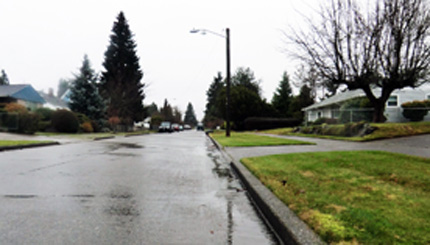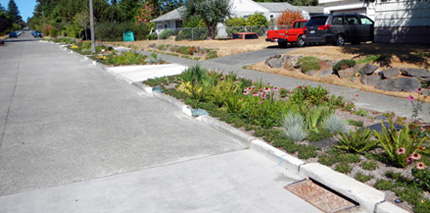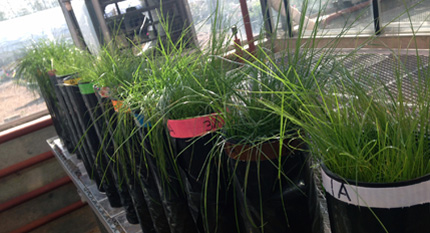Soil Science Society of America
5585 Guilford Road • Madison, WI 53711-5801 • 608-273-8080 • Fax 608-273-2021
www.soils.org
Twitter | Facebook
NEWS RELEASE
Contact: Hanna Jeske, Associate Director of Marketing and Brand Strategy, 608-268-3972, hjeske@sciencesocieties.org
Plants, soils take to the streets
Dec. 23, 2015 - The emphasis on "going green" in cities has led to a number of environmentally-friendly initiatives. But Sally Brown, a Professor at the School of Environmental and Forest Services and the University of Washington, would like cities to actually become green. She means green with vegetation. Specifically, Brown would like to see an increase in the use of stormwater bioretention systems.
Stormwater bioretention systems are alternatives to normal sewer systems. Traditionally, engineers design city sewer systems so stormwater moves away from streets. The water moves into drains and pipes that take it to wastewater treatment facilities or directly to rivers and streams.
Bioretention systems divert water away from sewers. Instead, the water goes back into the ground. Brown explains, "Here you are talking about having soils and plants do the work for you."
Using plants and soil to do all of the work may sound simple, but the inner workings are complicated. Creating effective bioretention systems requires understanding, and being able to design, a living system. This has been one of the issues preventing more communities from installing these green systems.
"Living systems can change over time," says Brown. "Understanding how they will function over multiple types of storm events across different seasons is very difficult."
These systems also create a need for compost, which is often made of food and yard waste. In addition to saving landfill space, composting waste reduces greenhouse gas release within the landfill.
Other ing redients for compost can include municipal biosolids and animal manures. However, current regulations often restrict the use of certain composts. According to Brown, these guidelines for compost and soil mixtures have little basis in soil science.
redients for compost can include municipal biosolids and animal manures. However, current regulations often restrict the use of certain composts. According to Brown, these guidelines for compost and soil mixtures have little basis in soil science.
In response, she and her colleagues studied how three different composts, each made with different materials, performed in simulated bioretention systems. The composts were mixed with sand in accordance with local guidelines. The researchers evaluated the mixtures for their ability to rapidly filter water, filter contaminants, and support plant growth.
So what did Brown and her team discover about the compost mixtures from their research? First, they found that all three compost mixtures removed contaminants like phosphorus, copper, and zinc, regardless of the mixture’s blend.
The research team also discovered another factor that might increase the soil's performance. One mixture included leftover materials from the local utility company’s treatment of drinking water. These residuals improved the filtering abilities of all of the compost mixtures. It may be important for removing contaminants.
The soil's ability to quickly filter water and contaminants is important if bioretention systems are used as alternatives to traditional systems. But they also need to look good while filtering water and contaminants.
“If designed poorly, these potentially pretty systems can become weedy eyesores," Brown says. Like any stormwater system, bioretention systems will still need maintenance. Rather than fixing leaky pipes, these systems will need weeding and pruning.
There are many potential benefits to bioretention systems. Potential perks include lower costs for water treatment plants, lower flooding risks for homes in low-lying areas, and increased public health benefits.
"Neighborhoods with these green systems look nicer and so people living near them are more likely to go for walks and are healthier as a result," says Brown.
Another perk is that these systems are effective in any green space. For example, people can create rain gardens in their backyards, and municipalities can use them alongside highways to reduce water on roads.
Overall, Brown and her team concluded the soil mixtures need evaluation in the field over time. "We are hoping that Phase III of our research will take us to the streets," Brown said.
What can ordinary citizens do to divert stormwater from the streets? Brown suggests mixing compost and sand and putting that into the soil near your downspouts. You can also talk to your municipal officials about incorporating bioretention systems into your community on a larger scale.
Click here to read more about Brown and her colleagues’ research in the Journal of Environmental Quality.
Journal of Environmental Quality publishes original research, reviews and analyses, and environmental issue articles that address anthropogenic impacts on water, soil, and the atmosphere and pertain to some aspect of environmental quality in natural and agricultural ecosystems.